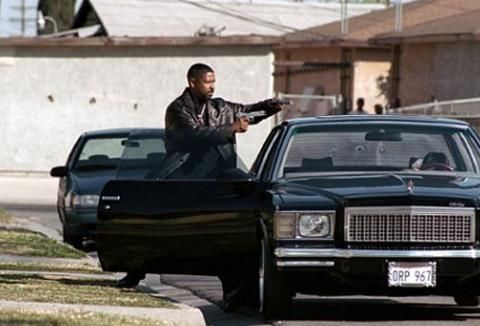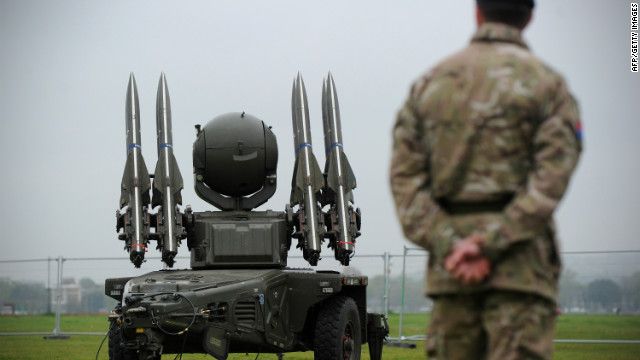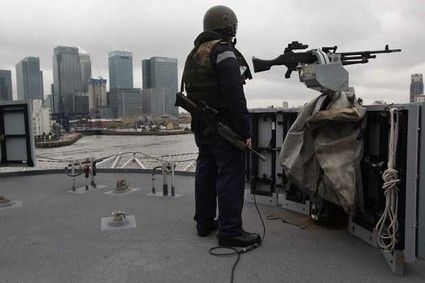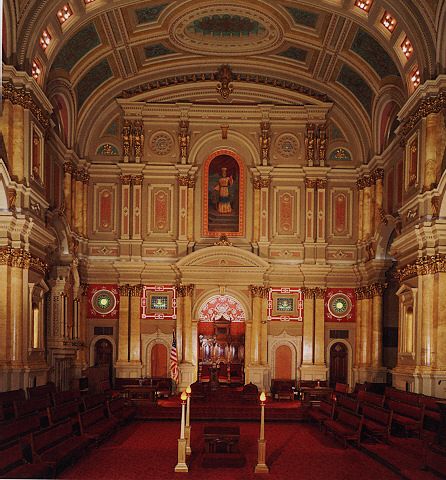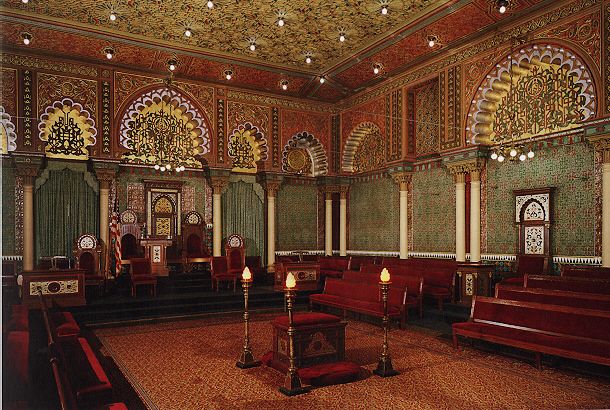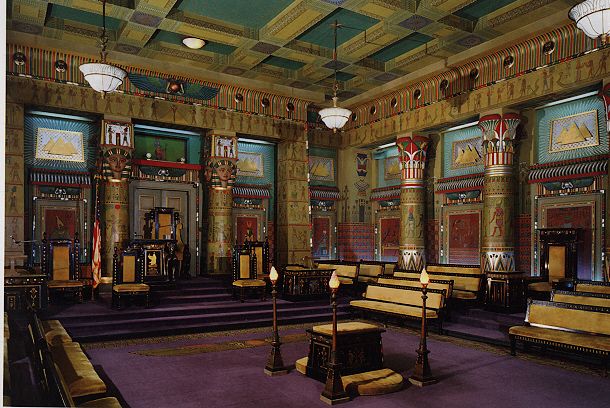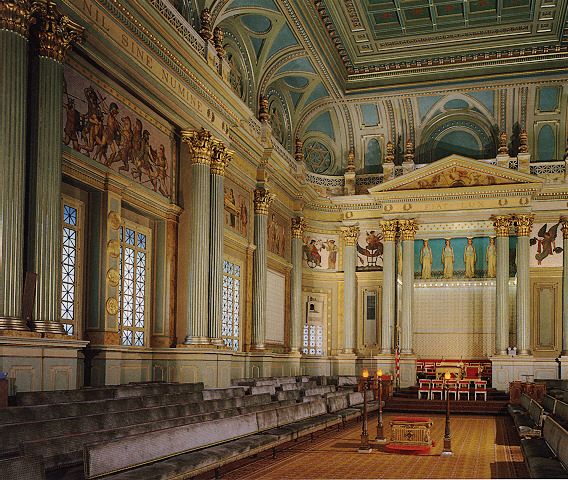Philadelphia's Franklin Institute, a science museum, is presenting a "blockbuster" exhibit centered around fragments of the
Dead Sea scrolls. The exhibition will be up through October 14.
The scrolls, around 2,000 years old, were found in caves at Qumran, Israel, verging on the Dead Sea. They are miraculously preserved copies of parts of the Old Testament and other texts, believed to have belonged to one of the many Jewish sects of the time.
I might as well say straight off that whatever their undoubted historical, religious, and archeological interest, the scroll fragments themselves at the heart of the exhibit are of limited appeal unless you can read Aramaic and other ancient languages they're written in. Furthermore, the scraps on display are small and, in aid of preservation, dimly lit. (Each fragment is accompanied by a photo enlargement, however.)
The showing is accompanied by several rooms of artifacts and audio-visual presentations designed to add context and atmosphere. I was right not to choose archeology as a career; it's hard for me to get excited about simple household implements and plain storage jars. Compared with the wondrous amphorae that the Greeks and Etruscans produced around the same time, these are of virtually no aesthetic interest.
But I began to warm to the artifacts after a while, not so much individual pieces as the overall sense they provided of life at that time and place. It's hard for most of us to imagine: primitive (I don't mean that in a negative sense), money-poor, practical, in a harsh environment. Nearby Jerusalem must have had its luxurious side, but out here by the Dead Sea shore only the voice of the people's God was heard.
To have painstakingly written the hundreds of scrolls that have been discovered testifies to the inhabitants' fierce commitment to their faith.

It's odd the things that strike one amid the many objects to see. Coins spilled from a small bag, looking almost new: Roman silver shekels and half-shekels. We were told this was the only form of money accepted for offerings in the Second Temple at Jerusalem. If you arrived with some other kind of money used by your tribe, you had to exchange them for Roman shekels at whatever the money changers (whose tables Jesus famously overturned) considered the going rate.
A section was devoted to Masada, where Jewish rebels against Roman rule held out under siege until they were finally overcome and committed suicide. Incredibly, a tattered piece of cloth had survived all the centuries to arrive in Philadelphia half a world away. The description said it had belonged to a Roman soldier who had served in the far northern reaches of the empire -- as evidenced by its simple but clear tartan pattern.
I mentioned the audio-video enhancements. Some of them, mainly the video ones, were helpful. Before admission to the exhibit proper, the stage was set in a room with screens on all sides, showing the Qumran environment where it met the Dead Sea. Grippingly lifelike.
The exhibition rooms themselves also had video screens, showing large images of some of the artifacts, rotating 360 degrees. Through some fantastical technology, they also stood out in a quasi-3D effect.
But the designers should have stopped there. Instead, they included recorded spoken descriptions, more or less repeating what was written in the captions, as if the visitors were illiterate. Some may have been deficient in the English language, of course, but for most people struggling with a foreign language it is easier to understand writing than speech.
To make matters worse, the rooms had no sound insulation from one another, so while you were looking at one part of the exhibition you were listening to a description of another part, or often two other parts. Even the room housing the scroll fragments and a segment of the Western Wall from Jerusalem, which should have enjoyed hushed silence, was wrapped in sound leakage from a short film next door, repeated over and over. Since this was where many visitors would spend the longest time, they were forced to hear the sound track dozens of times.
Anyone interested in Biblical archeology or the scrolls shouldn't miss this exhibit if they find themselves in Philadelphia. The presentation, however, could have accomplished more with less.
***
Now about Philadelphia itself. Granted, the impressions of a brief visit are hardly the whole story. They can be influenced by atypical incidents or extraneous conditions (and it was hellishly hot and humid). Having said that, the city's general atmosphere seemed to me to have deteriorated significantly since our previous visit, perhaps five years ago.
On a weekend, and especially after dark, the center city is a pathological circus act. Blacks driving around in open convertibles with rap music blasting the air; tattooed, drugged out and sickly hip white kids; drunks and mendicants. I don't know about the crime statistics, but it doesn't feel safe.
Your space isn't your own. My wife and I were walking along the ritziest street in town, Benjamin Franklin Parkway, which runs from the Beaux Arts city hall for a mile or so to the Museum of Art. We were returning from the Franklin Institute, about midway between them.
Two young black couples were heading our way. I didn't think anything of it -- they were just people out for a night on the town. As we started to pass them, they stopped. One of the males moved up to my wife and said, "Hey, I need a hug. Gimme a hug."
So here's this dude with his presumed girl friend, asking the woman of a couple he didn't know for a squeeze. Unbelievable. My wife had sense enough to ignore him, and so did I, but I was expecting trouble. There was none, but I was shaken up; I don't remember anything like it.
Our hotel was not at the Ritz Carlton or Four Seasons level, but it was supposed to be reasonably fancy. It is a 1929 art deco building that was once an office annex of the city hall. The architecture is intact, but not the vibes. Loud soul music playing in the lobby, a big electronic map and billboard, sales stands -- tacky but tolerable. However, there was a large slob component in the lobby. It's hard to say what percentage of its inhabitants were hotel guests and what percentage were hangers-out, but any remaining elegance in the setting was blotted out. It felt like a bus station.
Philadelphia appears to be desperately trying not to become Detroit or Baltimore, but it's a closely run thing. Fortunately for the city, it has tourist attractions galore, which hold back total decay. But the tourist districts are geographically small in proportion to the whole urban area, which ranges from uninviting to places best completely avoided. Not even the tourist and business districts are immune from blight. Philadelphia is on the shores of America's dead sea, the environment is again harsh, and the voice of the people's God is hard to hear through the noise.

